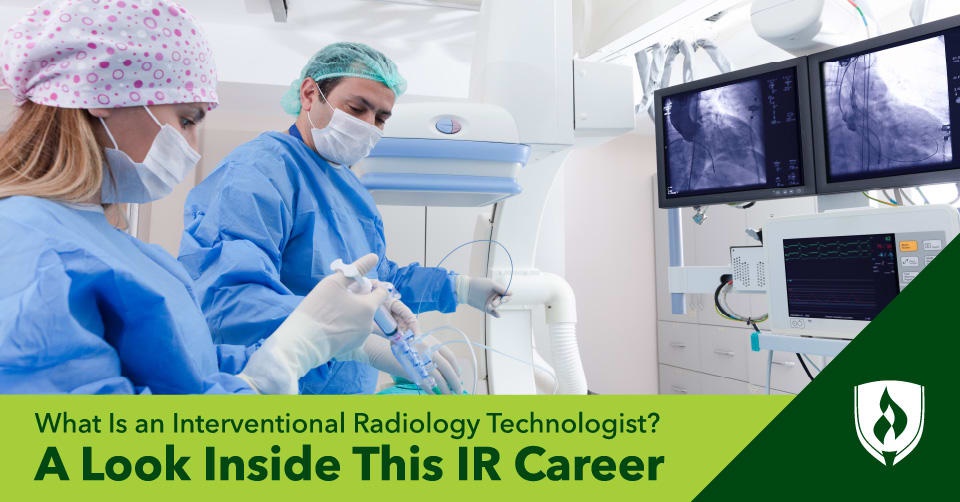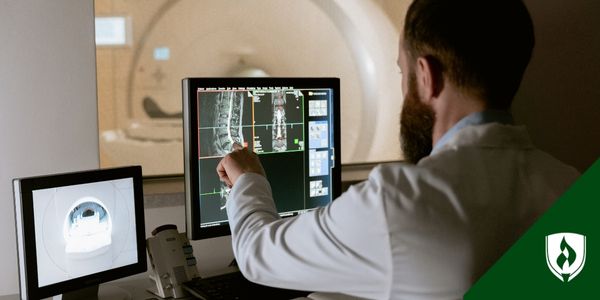What Is an Interventional Radiology Technologist? A Look Inside This IR Career
By Kirsten Slyter on 11/07/2022

While the health circumstances aren’t great for patients, having a chance to see broken bones, ruptured organs or suspect masses on imaging is a fascinating prospect to you. Diagnostic radiologic technologists get to capture the images that often lead to critical interventions. But there’s another side to radiology, interventional radiology (IR), that works directly in treatment.
In IR procedures, physicians, interventional radiology technicians (IR techs) and other allied healthcare professionals use fluoroscopy (essentially real-time X-ray), specialized wires, stents and other tools to visualize the patient’s condition in real time and also change what they see.
IR techs play an integral role in operating the imaging equipment and sometimes assisting in procedures. Whether you’re an established radiologic technologist, allied healthcare professional or you’re just exploring different career options, a career in IR is worth some consideration.
What is interventional radiology?
Interventional radiology is a branch of radiology that allows providers to perform procedures guided by fluoroscopy or other imaging modalities. Interventional radiology methods can address a wide range of diagnoses. A few common interventional radiology procedures include:
- Angiography: X-ray of arteries and veins to find any problems that are limiting blood flow
- Angioplasty: Insertion of a balloon-like device into a blood vessel to open a narrowing blood vessel
- Embolization: Method used to block blood flow, typically used for treating cancerous tumors
- Gastrostomy tubes: Placement of what’s commonly known as feeding tubes
- Stent placement: Method used to expand a blood vessel by placing a mesh coil
- Needle biopsy: Procedure where a tiny needle is used to take a sample of a suspicious tissue
- IVC filter: A small filter placed in the inferior vena cava to prevent blood clots that are at risk to enter a patient’s lungs
- Clot-medicine injections: Administration of certain medications to bust clots that can be given at the source of a clot
- Catheter insertions: Insertion of a tube under the skin into a major blood vessel to allow for easier venous access
Is interventional radiology like surgery?
There are similarities with surgery—for instance, both require sterile techniques and specially trained providers and support staff—but there are some big advantages to interventional radiology methods. These procedures are generally less invasive and safer for patients.
Typically, most IR procedures can be done in an outpatient setting, like at a same-day surgery center or during a short hospital stay. Plus, they generally do not require general anesthesia. Many use only mild sedation and/or local anesthetics to help the patient relax, though this depends on the provider’s and patient’s judgment and preferences.
What does an interventional radiology tech do?
IR procedures simply cannot happen without IR techs. Their imaging expertise is integral to the procedure. They administer the contrast dye that allows the provider to visualize the vessels and see what needs fixing. They also maintain and operate essential imaging equipment. Most use a C-arm machine that uses fluoroscopy to provide images for physicians. They also transfer and archive the images captured after the procedure.
Outside of capturing images, IR techs also interact directly with the patients by explaining the procedure and any risks from radiation. Alongside the rest of the team, they maintain sterile technique, monitor the patient’s vitals and interpret lab values. Some can also administer medications in accordance with state regulations.
What is rewarding and challenging about working as an interventional radiology tech?
In X-ray or other diagnostic rad tech positions, techs generally get to see the problem but don’t really get to follow the patient to see any clear resolution. In interventional radiology, IR techs not only get to see in real-time what’s wrong, but they also get to play a role in the procedure addressing the patient’s problem. While not every scenario plays out the way they hope, the ones that do can be incredibly rewarding.
At many hospitals, working in IR means being “on call.” That means if there’s an emergency, the IR team on call must be able to report to the hospital within 30 minutes. While IR techs will know in advance when these days are upcoming, few enjoy the strange in-between nature of an on-call day, as they can’t really commit to substantial plans.
Additionally, this is a role that requires teamwork and collaboration. Like with any collaborative role, this can be a blessing or a curse, depending on the team you work with and how well you adapt to different personalities.
How to become an interventional radiology tech
First, you’ll need to get established with radiologic technologist training and education. Most radiologic technologist programs are offered at an associate degree level. The Rasmussen University Radiologic Technologist Associate’s degree program, for instance, can be completed in as few as 24 months.1 Upon completion, you’ll want to pass the radiography certification exam administered by the American Registry of Radiologic Technologists (ARRT)®.
The next piece of the puzzle is typically building relevant experience, as some employers may prefer IR techs with previous X-ray tech experience. Keep in mind, this step or requirement isn’t universal for all employers—some may be guided by state laws, while others may come down to individual employer preferences.
Focus your radiology tech job search on facilities where interventional radiology is common—hospitals, outpatient clinics and same-day surgery centers. Even if you don’t start out in an interventional role, you can build useful experience and potentially seek out opportunities to cross-train in this specialty (which many employers are willing to facilitate). Once established, prospective interventional radiology techs may choose to seek out the vascular interventional radiography credential from ARRT. While there may be exceptions, many IR tech employers require employees to earn this credential within a certain time period after starting the job.
Can you see yourself as an IR tech?
One of the most straightforward ways to work in interventional radiology is to first get established as a radiologic technologist. Learn more about your first step in our article “How to Become a Radiologic Technologist: Examining Your Path.”
1Completion time is dependent on number of transfer credits accepted and the number of courses completed each term.
American Registry of Radiologic Technologists (ARRT) is a registered trademark of The American Registry of Radiologic Technologists corporation.




